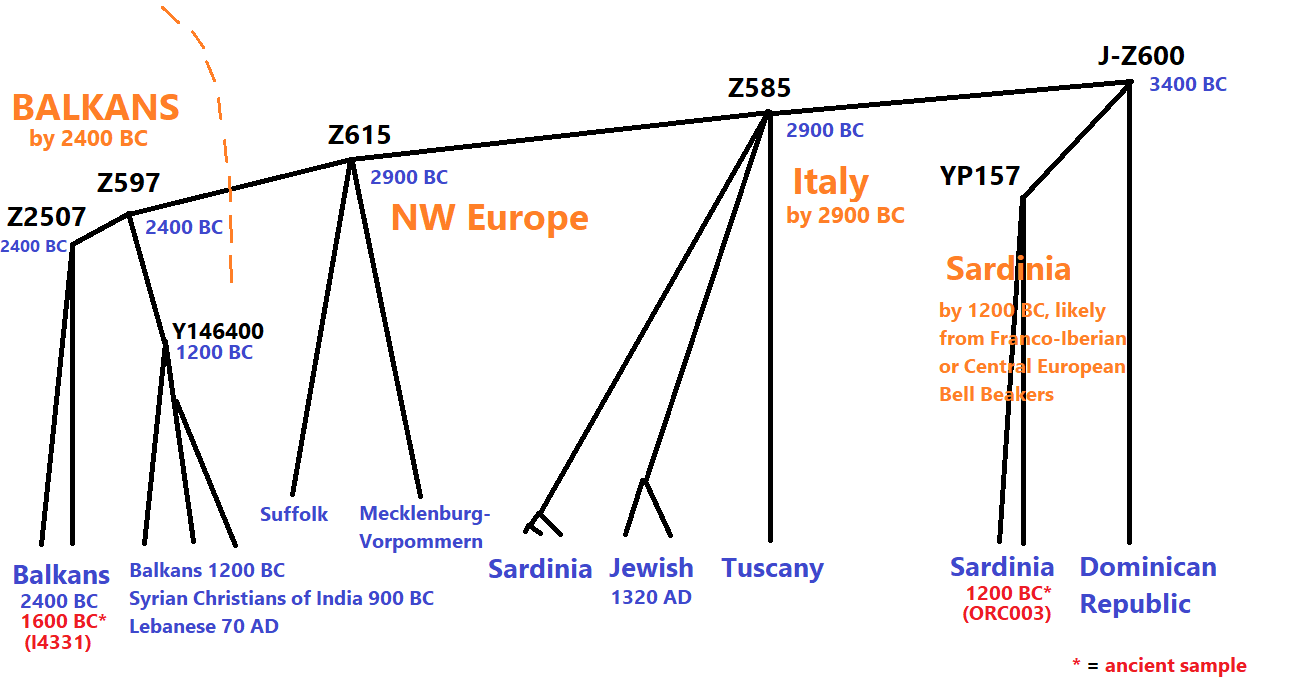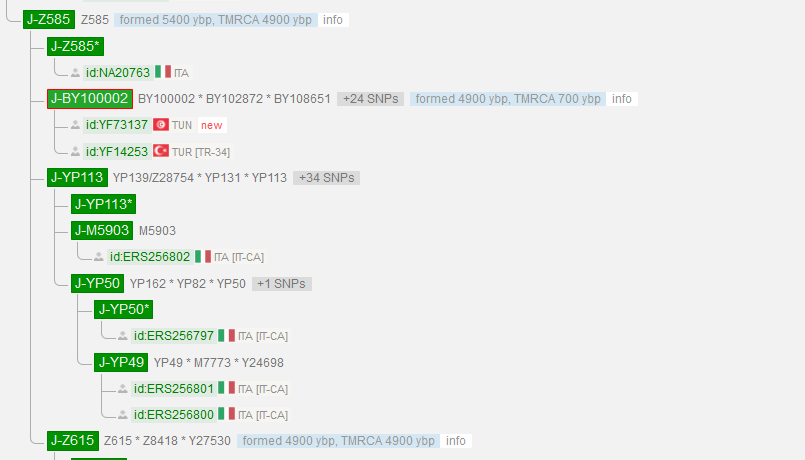Recently a man tracing descent to Tunisia and a Romaniote Jew tracing descent to Istanbul have been found to be very distantly related to the majority of living J-L283 men. As basal J-L283 samples are few and far between, this is a significant development for J-L283 research.

According to the oral tradition of the man of Romaniote Jewish tradition, his ancestors would have originated in Greece before migrating to Istanbul. Some links to Greece are found in his 12 marker STR matches to men from Ioannina.
I was not aware of the deep Jewish history in Tunisia. Like the history of Jews all over Europe, it is complex and involving multiple waves of migration.

The YFull analysis of these men's NGS tests resulted in the discovery of new lineage J-BY100002 and that their most recent common ancestor lived 700 years ago. The next closest relatives of these men are the lineages of J-Z585, with most recent common ancestor who live 2900 BC:
- J-YP113 Sardinians
- A Tuscan (NA20763)
- J-Z615 - three siblings: a German, Englishman, and J-Z597, a lineage that appears to have become established in the Balkans by 2400 BC
These areas are disparate but Northern Italy would seem to be a possible central location of the most recent common ancestor of J-Z585 who lived 2900 BC.
Circumstantial evidence implies that these men were living in Europe since 2900 BC though the oldest related ancient sample in Europe dates to 1600 BC in Croatia.
Unclear Geographical Origin of Jewish BY100002
Because only two men have done NGS and I have no detailed knowledge of the origins of the many other STR relatives in this Jewish group, I am not able to infer a specific geographic origin of their most recent common ancestor. Also, because their bottleneck goes back to 2900 BC, there is no way to know where their ancestors were living during this whole time.
It is even possible that this lineage may have been living in Judea or elsewhere in the Levant, despite the fact that all of their next closest relatives are living in Italy or elsewhere in Europe.
An interesting question that may never be known unless we are really lucky with ancient DNA, is whether or not this lineage or the other two old Jewish lineages of J-L283 trace their male line descent to Judea or elsewhere in the Levant.
Because ancient samples and modern diversity firmly establish the ancestors of J-Y33795 and J-Z33965 in Europe in the Bronze Age, a migration from Europe to the Levant sometime during the bottleneck would have to have happened for them to end up there.
Luckily, to aid our understanding, there is a precedent for migrations from the Balkans to the Levant in an Albanian/Lebanese/Syrian Christian lineage of J-L283 that I will next describe.
J-Y146401 - A Precedent for Iron Age or Roman Era Migration from Balkans to Levant
The oldest branch of J-L283 found in the Levant is J-FGC64029. It is also so far the only lineage in the haplogroup on YFull exclusively found in men tracing recent descent to the Levant.
Interestingly the next closest relatives of these Lebanese men are Syrian Christians of India (J-Y146401) and their most recent common ancestor lived 900 BC.
The next closest relative is an Albanian, with TMRCA 1200 BC. I think the simplest explanation is that the Syrian Christian of India's ancestor had previously been living somewhere in the Levant. This gives a window of 1200-900 BC for the presence of J-Y146401 in the Levant to be explained as one migration of a single man, their common ancestor, from the Balkans to the Levant.
Another example of a distant, possibly Roman-mediated, migration to the east is the Chechen lineage of J-Z1043>Y12007>FGC53823
Since this is just one man for now, we don't actually know when he migrated there, it could have been any time after 400 BC when his lineage split from one that would become, of course, Englishmen.
Time Windows for Possible Migrations of Jewish Lineages to the Levant
I will not assess likelihoods for these possibilities of a Roman-mediated or earlier migration of these lineages to the Levant. But I will provide some observations based on the following data.
Of the three lineages, J-BY100002 has the potential to have the oldest presence in the Levant but it also is the shortest attested exclusively Jewish lineage, meaning the adoption of Judaism may have occurred as late as 1300 AD. It also has no closely related ancient sample pegging it to Europe - the closest related sample is a J-L283* from the North Caucasus dating to 1800 BC. So the possibilities are less constrained.
J-Y33795 is unique among the lineages in being demonstrably the oldest, with most of the descendants of a man who lived 300 AD maintaining a tradition of Judaism. Its closest related ancient sample was an Etruscan buried in Civitavecchia dated 600-700 BC. Their TMRCA with this Etruscan is 1200 BC, so they have a potentially long window to have migrated to the Levant.
J-Z39653 is in the very prolific J-Z1043 lineage, which, while highly distributed within Europe, perhaps with an origin in the Balkans or Italy, has no presence in the Levant. Its closest related ancient sample was found in the Via Salaria Necropolis, dated 1-200 AD and is dubbed "Roman" though I believe an autosomal analysis categorized it as "western European" DNA for whatever that is worth. The closest relatives of this lineage were recently found to be a surname clan from England who have declined to do YFull analysis, so unfortunately we do not have a refinement of the age estimates. This lineage has the shortest window to have possibly migrated to the Levant, starting in 500 BC. So an Iron Age 1200-900 BC comigration from the Balkans to the Levant with J-Y146401 can be ruled out.
In short:
- Could the ancestors of these distantly related three Jewish lineages have been living in the Levant during or before the Roman Era, even though their closest relatives are Italians or other Europeans? - YES, there is precedent for an ancient migration from Europe to the Levant in one lineage of J-L283
- Could the practice of Judaism have begun in these lineages within Europe? - YES
- Is it plausible that the origin of J-L283 is in the Levant? - NO
To the last point, there are no ancient samples of J-L283 in the Levant but there are ancient samples in the North Caucasus (1800 BC), Armenia (1100 BC), Croatia (1600 BC), Sardinia (1200 BC), Etruria (600-700 BC). As there is no ancient or modern diversity in the Levant, I find this area to be unlikely to be the origin of J-L283.
Of course DNA doesn't make someone have a particular religion but as I have seen in several specific male lines in J-M205, J-Z2453 and J-L283, there are male lineages where the vast majority of modern descendants share a minority religion of Judaism or Christianity, in Europe and India, likely due to endogamy and very high rates of parent to child religious transmission.
This is as far as I'm currently able to provide information about the origins, as a non-expert on Jewish history, genetics or genealogy, just coming at this using the same methodology I use for all other groups.
If more of the men in J-BY100002 do NGS tests I hope we may be able to more precisely pinpoint where their ancestors were originally living, especially during the Iron and Bronze Ages as this would help inform our J-Z600 origin theories.
